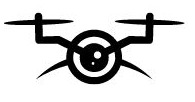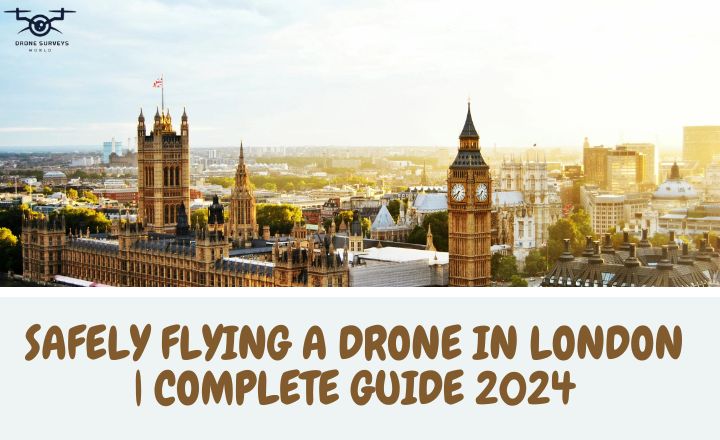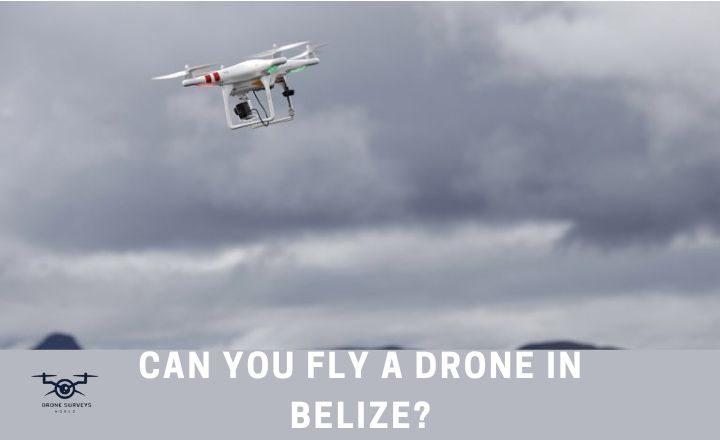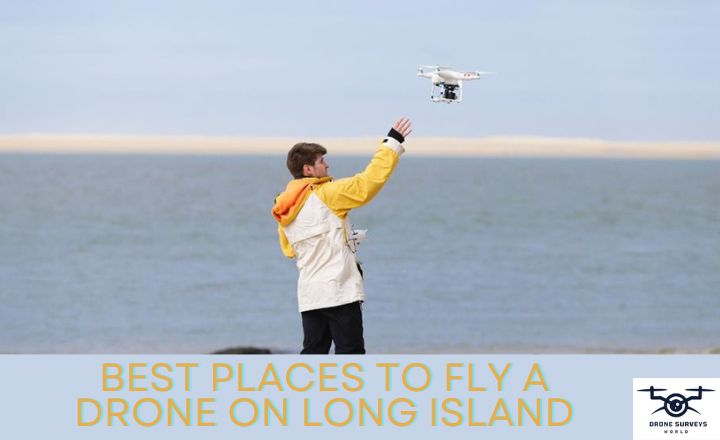London has landmarks, beautiful parks, and buildings, making it an excellent ace for drone fans. Drones are more famous for their photography and videography. If you are a beginner and flying a drone in London, it is essential to know that there are strict rules and regulations to follow. All these rules are described below:
London Drone Laws And Regulations
For flying a drone in London or anywhere in the UK, you need to follow specific rules set by the Civil Aviation Authority (CAA) to make sure you fly safely and responsibly.
Drone License Registration In London
If you’re a commercial drone pilot with a drone weighing between 250 grams and 20 kilograms, you must register with the CAA. All drones with a camera, no matter how much they weigh, also need to be registered in the UK. You’ll need to pass an online test and get a Flyer ID and an Operator ID. These IDs must be on your drone whenever you fly it.
The main points about getting a drone license and registering in London are:
- You need to be at least 12 years old to fly a drone on your own.
- If you’re under 12, you need to be supervised by someone 16 or older, and both of you need to pass the Flyer ID test.
- Drones with cameras need an Operator ID from the CAA.
- If you’re using your drone for business, you need to have insurance.
Regulations For Flying A Drone In London
The CAA has set rules for safe drone flying in London and the UK.
The rules are:
- Don’t fly higher than 400 feet (120 meters).
- Always see your drone.
- Get permission before flying near airports.
- Stay at least 50 meters away from people. If your drone is under 250 grams, you can fly closer to people and over them.
- For drones over 250 grams, stay at least 150 meters away from parks, industrial sites, residential areas, and built-up zones.
- These rules also apply at night.
Following these rules will help you have a safe and responsible drone flying experience in London while capturing great aerial footage of the city’s landmarks and parks.

Preparing A Drone To Fly In London
Before taking your drone to the skies in London, there are a few important steps to ensure a safe and successful flight:
Choose The Right Drone
To fly a drone in London, you need to choose the right drone based on how you plan to use it and your budget. If you’re a casual hobbyist, a smaller, cheaper drone may work for you. But if you want professional-quality images, you should invest in a drone with high-quality camera and with advanced features.
Check The Weather Forecast
London’s weather can affect your drone flying. Heavy rain, strong winds, and fog can make it hard to fly your drone safely. So, always check the weather forecast before you fly.
Drone Insurance
While you don’t have to have drone insurance by law, it is a good idea to get it. Some policies cover accidental damage, loss, or theft. Others provide liability coverage if your drone causes injury or property damage.
Where You Can Flying A Drone In London | Checking No-Fly Zones
When you plan to fly your drone in London, it is important to know where it is safe and legal.
Here is how to use it and determine where you can fly a drone in London:
- Visit the Altitude Angel Drone Safety Map Website.
- Zoom in on the map to find London or use the search bar.
- Look for safe areas for drone flights without restrictions or hazards.
- Pay attention to no-fly zones like airports and government buildings.
- Check the weather and other hazards to make sure your flight will be safe.
Borough Drone Rules In London
Navigating drone regulations in London’s boroughs can be tough for hobbyists and pros. Each borough has its own rules for drone operations, which must be followed for safe flying. This guide gives an overview of drone pilot rules in different London boroughs.
Understanding these rules is crucial for pilots who want to capture aerial footage of London’s landmarks and landscapes while following local regulations.
| London Borough | Drone Permission Required | Application Process/Email | Additional Notes |
| Greenwich | No official policy | N/A | Always check for updates on local regulations |
| Lambeth | Not allowed in parks | N/A | Exceptions for authorized events |
| Richmond Upon Thames | Yes | This applies to all congested areas such as Lewisham, Dagenham, Barking, Redbridge | Public Spaces Protection Order 2020 |
| Hackney | Yes | Hackney’s FilmApp application system | Public liability insurance (£5,000,000) & risk assessment required |
| Chelsea (Congested) | Not allowed | N/A | Applies to all congested areas such as Lewisham, Dagenham, Barking, Redbridge |
Note: This table shows the drone rules in different parts of London. Check with the local council or authorities before flying your drone. Follow the UK’s Civil Aviation Authority rules and the Drone Code for safe and responsible flying.

Drone Flying Regulations In Hackney
To fly a drone for fun in Hackney, you have to follow strict rules because you can’t fly drones in the parks.
Application Process
Before you fly your drone, you need to tell Hackney Borough what you’re planning to do. This is to make sure your drone flight is safe and won’t cause any problems.
- To apply, go to Hackney’s FilmApp system and fill out the form.
- You need to say where and when you want to fly your drone.
- Describe why you’re doing it, like for filming or taking pictures.
Additional Requirements
To fly a drone in Hackney, you need to do more than just apply.
- You also need to get insurance with at least 5,000,000 in coverage. This insurance is important in case there are accidents or damage from your drone.
- If you want to film on council property or public highways, you should do a risk assessment. This will help you identify potential dangers and plan how to reduce these risks when you fly your drone.
Greenwich Borough Drone Laws In London
Greenwich Borough in London, England, is famous for its historical sites like the Greenwich Observatory. There are no official drone laws in place for flying drones in Greenwich.
Drone pilots must get permission before flying in public parks or open spaces in the borough. They should know the rules set by the local council before flying in public areas. Policies may change, and some areas may be off-limits for drones.
Nearby boroughs like Barnet and Camden have similar rules. Pilots should always check local policies before flying, no matter where they are. This helps them fly safely and responsibly without breaking any laws.
Drone Flying Regulations In Chelsea And Other Congested Areas
Drone flying is not allowed in congested areas like Chelsea, Lewisham, Dagenham, Barking, and Red bridge. This rule applies to all parks and open spaces to keep people safe and protect their privacy.
Congested Areas Restriction
In congested areas, there are more people and a higher risk of drones causing problems with buildings and other aircraft. The Civil Aviation Authority (CAA) makes strict rules to keep the public safe and protect their privacy and security. Some of the main reasons of restriction include:
- Air Traffic Management: Crowded areas have a lot of air traffic, like helicopters and other low-flying planes. Limiting drone flights in these areas can reduce the risk of crashes.
- Safety Concerns: Drones can be dangerous in crowded places. Limiting drone flights in these areas can help prevent accidents and injuries.
- Privacy Considerations: Drones with cameras can take pictures of people without their permission, which can be a privacy issue. Limiting drone flights in crowded areas can protect people’s privacy.
- Security Concerns: Sometimes, drones can be a security risk, especially in places with important buildings or events. Limiting drone flights in crowded areas can help keep things safe and stop unauthorized spying.
Stay Informed And Make Sure You Follow The Rules
Before flying a drone, make sure you know the rules for the area. Check with the local council or visit the CAA’s Drone Safe website for the latest information on where you can and can’t fly your drone. Following these rules will help you have a safe and fun time flying your drone while respecting others’ safety, privacy, and security.
Drone Flying Regulations In Lambeth
In Lambeth, it is against the rules to fly drones in the parks. This applies to all parks in the borough. To stay updated on any rule changes, check with the local council before planning any drone flights in the area.
Exceptions For Authorized Events
Authorized events are the only exception to Lambeth’s drone restrictions. If you are legally flying your own drone or part of an authorized event, you may be allowed to operate your drone in specific locations or under certain conditions. Before flying, it is important to check with the show operator or local council to make sure you are following the latest regulations.
Drone Flying Regulations In Richmond Upon Thames
Drone flying in Richmond Upon Thames is limited. The Public Spaces Protection Order 2020 prohibits drone flying without prior consent. This means you need permission from the landowner or occupier before flying a drone in their area. Not getting permission could lead to penalties or legal consequences.

Approved London Drone Flying Zone
If you are starting to fly a drone in London, search about the approved flying zones for security:
Ealing
You can fly a drone in Ealing if the park ranger allows it. But you can’t fly in Gunnersbury Park, Hanwell Zoo, or nature conservation areas.
To get permission to fly in a park in Ealing, follow these steps:
- Email parks@ealing.gov.uk with your request.
- Tell them the name of the park.
- Tell me the date you want to fly.
If the park ranger permits you and you follow the rules, you can fly your drone in Ealing safely. Check for any rule changes and ask the park ranger or local council if you have questions about flying drones in the area.
Richmond Park
Richmond Park in London is a great place for people who like flying drones. The park has open spaces and specific areas for flying drones.
There are some rules to follow when flying in the park:
- Don’t fly drones with a wingspan bigger than 1m (4m for gliders).
- Don’t fly after 13:00 on weekends or bank holidays.
- Don’t fly higher than 100m (330 feet).
- Don’t fly if there are deer around.
- Don’t do competitive flying or launch balloons or rockets.
- Don’t use virtual reality headsets.
- People flying drones need to have insurance.
Drones and model aircraft are only allowed on the Flying Field in Richmond Park. This makes sure that everyone in the park stays safe and has a good time.
Drone No-Fly Restriction Areas In London
If you want to fly a drone in London, be aware of three no-fly zones in Central London called R157, R158, and R159. It is important to know where these zones are before flying your drone to follow the rules and keep people safe.
Before flying to new areas, it is important to check with your local council.
Battersea Heliport Drone Flight Applications
If you want to fly a drone near Battersea Heliport in London, you need to follow specific rules.
- You must submit a form and a map 48 hours before flying.
- Pay a fee.
- contact air traffic control before launching.
- You also need to have insurance for aviation risks.
Charges
You must pay a fee to get permission to fly model aircraft in a specific area. If you want to fly in the same area again within 12 months and nothing has changed, you don’t have to pay again. But if you want to fly more times or in a different area, you need to get permission again.
| Assessment and Permit for Operating UAVs | Price (plus VAT) |
| Within the ATZ and outside the circuit (including R157 restricted Airspace where it coincides with ATZ) | £25.00 (£30.00 incl.) |
| Within ATZ and Circuit (Approach and Take off) | £150.00 (£180.00 incl.) |
To apply to fly your drone at Battersea Heliport, you can find the contact details on their website.

R157, R158 & R159 Restricted Flying Zones
Drone pilots need to know about three restricted flying zones in Central London: R157, R158, and R159. You can’t fly in these zones unless NATS approves it. To get approval, submit a non-standard flight (NSF) application at least 21 days in advance. Approvals for London-restricted zones may take longer.
When you apply, include
- The start and end dates of your flight.
- The maximum height you plan to fly.
- A map of your flight path.
- Accepted file types for the map include kml, kmz, pdf, and zip. If you have multiple files, put them in a zip file.
London City Airport Drone Operations
If you want to fly your drone near London City Airport, you need to tell the airport authorities. Here is what you need to do:
- Assess and document your drone: All drones used in the airport’s airspace need to be checked and recorded by London City Airport and NATS.
- Get permission from the CAA: If you’re using your drone for business, you must get permission from the Civil Aviation Authority (CAA) under Article 94 of the 2016 Air Navigation Order (ANO 2016).
- Check the flight restriction zone (FRZ): There’s a 5km no drone zone around London City Airport. The zone goes from Canary Wharf to Thamesmead, and from Woolwich to East Ham.
- Apply for a Non-Standard Flight (NSF) approval: To fly your drone in the FRZ, you need to get approval from NATS at least 21 days before your planned flight. If you apply less than 7 days in advance, your application may not be processed.
- Submit your NSF application: When you apply, include your flight details like path, dates, and maximum height. NATS will send your application to London City Airport and other airspace groups for review.
- Obtain approval from NATS: You must get approval from NATS before flying your drone in the airport’s airspace.
- Follow all regulations and guidelines: As a UAV pilot, it is your responsibility to follow all rules and guidelines for drones. Don’t take off unless you’re sure you can safely complete your flight.
Heathrow Airport Drone Application
To fly a drone near Heathrow Airport, you need to get approval to make sure the airspace is safe. Here is what you need to do:
- Request an NSF approval from NATS: First, ask NATS for permission to fly in the Flight Restriction Zone or Runway Protection Zone. You can do this at https://nsf.nats.aero/drones-and-model-aircraft/.
- Ask Heathrow’s Works and Safeguarding Manager for approval: Then, you also need to get approval from Heathrow’s Works and Safeguarding Manager. You can contact them at safeguarding@heathrow.com to talk about getting approval or if it is possible to fly a drone at the airport.
- Wait for approval: Don’t fly drones near Heathrow until you get approval. Wait for all necessary approvals before flying your drone near the airport.
Thames
To fly your drone over the River Thames, follow these guidelines for safety and legal compliance.
- Notify the Port of London Authority (PLA): at least 3 working days before your flight to ensure it doesn’t endanger anyone using the river. Use the Drone Online Notification Portal to provide all the necessary details.
- Get necessary permissions: If you want to fly your drone over the River Thames, get permission from different authorities like the Civil Aviation Authority, National Air Traffic Services, and local authorities and landowners. If your drone flight will affect nearby land, you need to get consent from the landowner.
- Follow the rules: As a drone operator, you must follow the rules and codes of practice. Make sure you know about any restrictions or requirements, like exclusion areas or permissions needed to fly near important places or structures.
- Get a filming license if needed: Some drone flights over the River Thames may need a filming license. If that is the case, the PLA will ask you more questions and give you instructions.
- Get written permission from the owner of the land by the river: Before flying your drone near the river, make sure you have permission from the landowner.
Follow the rules and laws to keep your drone flight over the River Thames safe and responsible.

London Landmarks And The Rules Around Flying Drones
London has famous landmarks that many tourists visit. If you like flying drones, you need to follow rules when flying near these landmarks. If you don’t follow the rules, you could get fined, go to jail, or have your drone taken away.
Buckingham Palace
Buckingham Palace has a no-fly zone because it is in a busy area with lots of air traffic. Drone pilots need special permission to fly there.
London Bridge
London Bridge also needs special permission to fly drones or aircraft nearby. Pilots have to follow any restrictions that are in place.
Tower Bridge
Flying small drones over Tower Bridge without permission is illegal. Pilots need approval for non-standard flight permissions before operating in this area.
St. Paul’s Cathedral
St. Paul’s Cathedral is a historical and architectural gem, but drone pilots must get non-standard flight permissions before taking aerial shots of the landmark.
Shard
The Shard, the tallest building in the UK, offers breathtaking views of the city. Flying drones around the building requires non-standard flight permissions.
British Museum
The British Museum is a prime location for drone photography, but pilots must also secure non-standard flight permissions.
Trafalgar Square
Trafalgar Square is a busy public space that attracts many visitors every day. Drone pilots need special permission to fly in this area to keep everyone safe.
Houses Of Parliament
The Houses of Parliament, also called the Palace of Westminster, is a symbol of British democracy. Pilots who want to take aerial photos of this landmark need to get special permission to fly their drones.

Tower Of London
The Tower of London has a rich history and beautiful architecture, making it a great subject for drone photography. Pilots need special permission to fly their drones around the tower.
Royal Observatory In Greenwich
The Royal Observatory in Greenwich is home to the Prime Meridian and Greenwich Mean Time, making it an interesting place for drone photography. Pilots must get special permission to fly their drones in this area.
Coca-Cola London Eye
The Coca-Cola London Eye is a famous observation wheel that offers a unique view of the city. Pilots flying drones near this attraction must get special permission and follow specific guidelines to fly safely.
Tate Modern
The Tate Modern is a well-known contemporary art museum in a former power station. Drone pilots who want to capture the museum’s unique architecture must first get special permission to fly.
Natural History Museum
The Natural History Museum is a must-see landmark in London with beautiful architecture and captivating exhibits. Drone pilots need to get special permission before flying near the museum.
Conclusion
Flying a drone in London requires following strict rules set by different authorities. Drone operators must know about restricted areas, get specific permissions, and follow safety measures. Always check with local councils, landowners, and air traffic control before flying. The above guide will help you!
Frequently Asked Questions
Can I Fly my Drone at Night in London?
Flying drones at night is generally not allowed unless you have obtained special permission from the CAA.
Are There any Height Restrictions for Flying drones in London?
Drones must not be flown above 400 feet (120 meters) in altitude within controlled airspace over urban areas like London.
Do I need Insurance to Fly a Drone in London?
It is highly recommended to have insurance coverage when flying a drone in London to protect yourself from liability.





